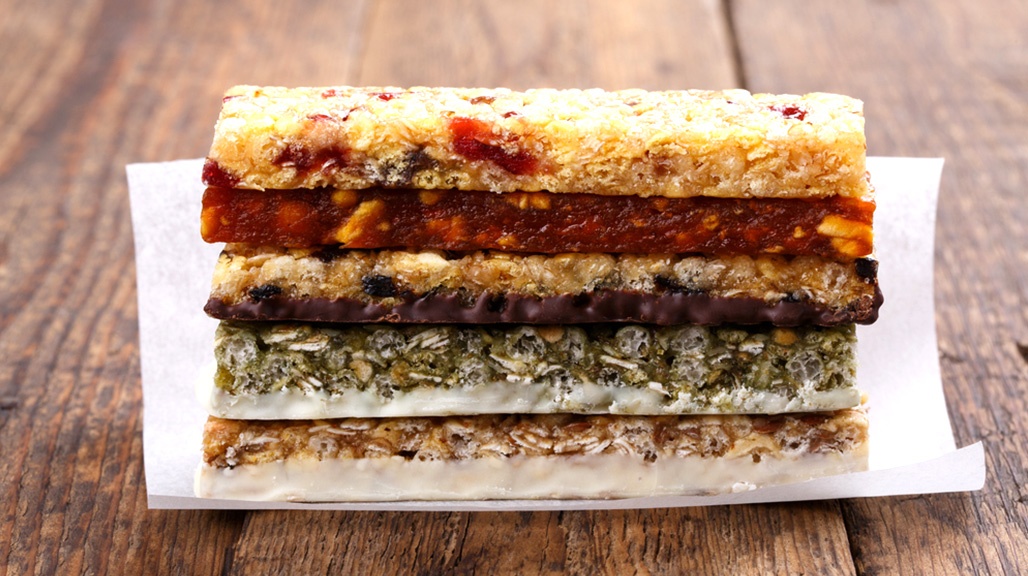Nutritional Bars: What You Need To Know
 Contributed by
Pauliina Salmenhaara
January 17, 2017
Contributed by
Pauliina Salmenhaara
January 17, 2017

Nutritional bars serve a beneficial function when prepared with clean, wholesome ingredients.
However, they are far from great when highly processed and pumped up with sugars. You know the hard-to-bite, almost candy-like bars I’m talking about? Or the ones which are almost dripping with syrup?
From weight loss bars, energy bars, and low carbohydrate bars to protein and granola bars, these cheerful-looking snacks are saturating the market today. With their small and light packaging, on-the-go food like these “health” bars are on the rise due to today’s busy and energy-depleting lifestyle. Sadly, many people fall victim to the promised health benefits on the “nutritional” bar packaging, without reading through the ingredients or thinking of the processing. In fact, some of them serve quite the opposite function.
When professionally and ethically prepared, nutritional bars can serve a wide variety of needs and functions, through variations in nutrient and vitamin doses calculated to sustain precise purposes. Some are tailored specifically for athletes or for those in need of a mental alert boost.
Being aware of the differences in bars as well as the quality and balance of the ingredients can guide you in choosing the one that is best for you.
Types of Nutritional Bars
Weight-Loss Bars – Contain fewer calories and nutrients, with the main purpose to boost metabolism. Please use only if no other option available is available for a one-off thing, not as an actual lifestyle or regime.
Low-Carbohydrate Bars – Made purposely for people on a low-carb diet, either to lose weight or maintain their blood sugar levels. Low-carb bars are moderately high in protein and fat.
Meal Replacement Bars – Specially made in substitution for a complete meal. That being said, these kinds of nutritional bars should have a sufficient supply of protein, carbohydrates, fats, and a maximum of 300 calories.
Mass Bars or Mega-Calorie Bars – Loaded with tons of calories and containing a big variety of nutrients. Depending on how transparent a company is, only a few provide quality nutrient content. Many of the mega-calorie bars are marketed as healthy ones, but in reality they are your typical candy bars in camouflaged packaging.
Energy Bars – Mostly used by professional athletes and gym goers, energy bars are sports nutrition supplement bars containing stimulants such as high carb cereals and caffeine. Their main function is to provide a quick energy fix before or after rigorous activity.
Protein Bar – A supplement bar for a great source of a protein boost. In comparison with energy bars, protein bars provide mainly protein needed by the body to maintain and build muscle, hence commonly eaten after a workout.
Watch out: Is it real protein, or an inferior quality component such as gelatin, hydrolysed collagen, or hydrolysed gelatin, which are boiled animal scraps like skin, bones, and connective tissues? Somehow, these still pass as protein.
Others:
Granola Bars – Today’s new craze bar – granola – is high in fiber, which helps in digestion. The oats in granola make food digested in our body last longer, keeping us full for a longer period of time. Watch out for the sugar.
Trail Mix Bar – Popular with hikers and mountaineers, the trail mix bar is made from your typical trail mix packs – peanuts, almonds, cashews, seeds, and raisins. A trail mix can be full of protein (nuts and seeds), carbs (bananas, raisins), and vitamins. We like to make our own with sprouted seeds and soaked dehydrated nuts, as well as superfoods such as spirulina, maca, bee pollen, and gojis.
Are They Good For You?
Nutritional bars can be a wonderful source for more energy, strength, and fitness. If buying store-brought ones, use them for the short term if they are your best option. If looking to use them long term for specific purposes, make sure you are properly guided, consume quality ones – making your own is the best option – and still eat proper meals. Also, limit yourself, as over consumption can cause diarrhea and liver damage.
With most nutritional bars made from a high amount of sugar and fructose syrup, your health may end up with a hit of more than 350 calories per bar, higher than the maximum prescription. Don’t always believe the hype text. According to ABC news, “In 2001, an independent testing company analyzed energy bars and found that 60 percent of the bars tested failed to meet label claims concerning calories, carbohydrates, fat, protein, sugars, and other ingredients.”
As a consumer, we need to be accountable and responsible for our health.
Here are tips on buying nutritional bars:
- Read the labels carefully.
- Know the ingredients that are good or bad for you. For example, if you need to lessen your sugar intake, choose bars that only use dry fruits as a sweetener.
- Calories should range from 170 to a max of 300.
- Look for bars that only have 2- 5 grams low saturated fat.
Avoid:
- Bars with more sugar than protein and fiber.
- Corn syrup, cane invert syrup, fructose syrup, and malitol syrup, brown rice syrup, agave nectar.
- Artificial colours and chemical preservatives.
- Gelatin and partially hydrogenated oils.
- Sugar alchohols ending in “ol”, such as xylitol and maltilol. These can cause diarrhea and irritate the digestive tract.
Do:
- Make sure the first listed ingredients are healthy, as these are the ones which are in greatest mass in a product. Soy rice crispies would be one to avoid as a first ingredient, as it acts as a filler and is plain sugar.
- Pick bars with quinoa, flax, hemp.
- Your research and/or ask your trusted doctor / nutritionist for advice.
- Look for honest reviews in independent websites or forums.
We recommend nutritional bars which are composed of:
- Vegan protein such as hemp and chia seeds and pea protein (not whey-based protein or overly processed soy by-products).
- Quality fats (coconut oil, almond butter, cacao butter)
- Natural carbohydrates (not sugar alcohol or high fructose corn syrup).
We at R.A.W Inside Out believe that no bars can substitute a healthy, wholesome meal combined with mindfulness, love, and exercise. The best way is to make your own nutritional bars.










Sorry, the comment form is closed at this time.